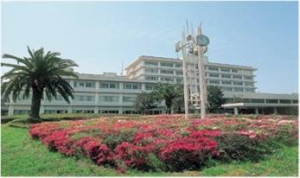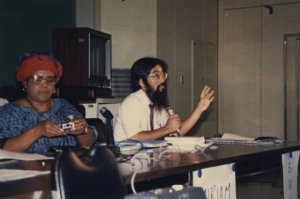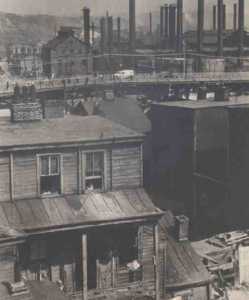2月1日(木)5-6(1:30:-3:00)15回目、最終回でした。つき合ってくれてありがと。感謝しています。
写真(作業中)
小島けいカレンダー「私の散歩道2021~犬・猫ときどき馬~」2月
高校7年3か月(うち2年は大学院)、大学非常勤5年、医科大・医学部28年、非常勤1年、語学教育センター5年、46年3か月、大学に小説を書くために来たのに、長かったねえ。
来た当時の宮崎医科大学(ホームページより)
案内:→Zoomトーイック4、Zoomシンポジウム2021
<今日>
①発表:
グループ1(緒方、門田、小出、田中、春山):趣味について
グループ2(小城、河野、小金丸、永吉、開田):コロナが落ち着いたらしたいこと
グループ3(奥村、木原、染田、林(聡)):それぞれのゼミの深掘り
グループ4(岩井、迫田、外岡、松原、吉岡):ご当地グルメ
グループ6(鬼塚、中川、服部、堀田):ゼミを詳しく
グループ7(入江、迫、羽田野、林(航)):今までのを深化
②ひとりひとりから授業の感想。
いろいろ聞かせてくれてありがと。4月からは授業なしです。先週退職届と、再雇用なしの書類にサインを求められました。頼まれて引きうけ、10年ほどのんびりやって下さい、という話やったのに、退職届と、再雇用なしの書類にサイン、とはねえ。僕がそんなに厄介な存在やったんやろか、と思ったりして。
作家として売れても、大学には顔出さんでえ。ま、売れてから言ってくれ、と言われそう。
小説、売れるかどうか、僕が選ぶわけやないんで、どうやろね。ペンネームは不破次郎。
元気で、ね。
1989年、医科大に来た翌年のミリアム・トラーディ講演会(同時通訳をして40度の熱を出しました。英語が体に合ってないみたい。今もそうやけど、40年以上も授業をしたなんて、ねえ。人生何が起こるかわからんよねえ。)
Zoomトーイック4
<Zoomトーイック案内>
*課題や試験が終わって一段落する2月終わりか三月初めから開始予定、日程が決まったら連絡。)
それまでに先ずはPart1を自分で繰りり返しやって、Zoomトーイック4では答えを確認、分かり難かったことや質問でお互いに確かめ合う。自分でやれない部分を質問などや、他の人の反応などで確認する。
*資料(4冊分7種類のテスト)は可能な限り開始時までに参考ファイル↓に置いてるんで、順次繰り返してやっておくと成果が出ると思う。Part 5(zip)は置いてあります。
2018年後期 南アフリカ概論(後期用) →
https://kojimakei.jp/tama/topics/classes/c2018b/c2018sab/okiba/upload.html
(ユーザー名: c2018sab パスワード:G9mr )
*2回目からは月1回の予定で。。
*まだの人は先ずは650、それから800、最終的には全員900を目標に。800まではつき合います。
*できる限り質問、疑問をお互いに共有して、広く、深く力をつけられると、変動なくスコアが取れるようになると思う。
参加する人はメールをもらえれば招待状を送ります。
Zoomシンポジウム2021
Zoomシンポジウムについて
多文化多言語教育研究センターの玉田、寺尾、杉村の3人で初めてのZoomシンポジウムを行ないます。
科研(玉田)のタイトル「アングロサクソン侵略の系譜」の流れで、第二次世界大戦直後の体制の再構築に関連する話です。
2月20日(土)10:0~12:00
玉田吉行「体制再構築の第一歩―ガーナとコンゴの独立時」
寺尾智史「列強による分断の果てに――赤道ギニアのビオコ島、アンゴラ飛地のカビンダの現代史」
杉村佳彦「マオリの都市化―戦後不況を乗り越えて得たもの―
司会:中原愛(知己資源創成学部2年)
今回は参加者10~20人くらい、積極的に意見や質問をしてもらえるようにと考えています。
連絡を下されば招待状を送ります。tamadayoshiyuki@gmail.com
玉田吉行
クラス名簿
2020年後期 英語 Ra 2 (3)クラス名簿(31名)(2020年10月26日現在)
| 30200038 | 生田 志潤 | イクタ シジユン |
| 30200087 | 植村 尊 | ウエムラ タケル |
| 30200148 | 小野 拓海 | オノ タクミ |
| 30200173 | 加知 倫太朗 | カチ リンタロウ |
| 30200205 | 川越 晴登 | カワゴエ ハルト |
| 30200214 | 河野 晃輝 | カワノ コウキ |
| 30200308 | 齋藤 優奈 | サイトウ ユウナ |
| 30200317 | 坂元 美琴 | サカモト ミコト |
| 30200360 | 重山 夕美 | シゲヤマ ユウミ |
| 30200371 | 篠原 小伯 | シノハラ コハク |
| 30200384 | 下條 帆乃佳 | シモジョウ ホノカ |
| 30200399 | 菅付 彩友 | スガツケ アユ |
| 30200447 | 恒吉 実於 | ツネヨシ ミオ |
| 30200454 | 角田 楓 | ツノダ カエデ |
| 30200472 | 堂薗 翔永 | ドウゾノ シヨウエイ |
| 30200520 | 戸島 脩太 | トジマ シユウタ |
| 30200579 | 永松 日向 | ナガマツ ヒナタ |
| 30200582 | 中屋敷 香波 | ナカヤシキ カナミ |
| 30200597 | 原田 佳純 | ハラダ カスミ |
| 30200603 | 東久保 光汰 | ヒガシクボ コウタ |
| 30200612 | 日田 快希 | ヒタ ハルキ |
| 30200627 | 平井 優季 | ヒライ ユキ |
| 30200704 | 福留 駿佑 | フクドメ シユンスケ |
| 30200742 | 本田 拓哉 | ホンダ タクヤ |
| 30200759 | 待山 功星 | マチヤマ コウセイ |
| 30200795 | 松山 峻平 | マツヤマ シユンペイ |
| 30200807 | 間野 壱晴 | マノ イツセイ |
| 30200821 | 宮崎 琉奈 | ミヤザキ ルナ |
| 30200869 | 山口 澪夏 | ヤマグチ ミオカ |
| 30200898 | 吉田 晴紀 | ヨシダ ハルキ |
| 30200926 | JIANG TIANCHENG | コウ テンセイ |
<今日>


